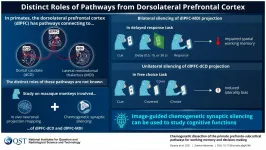Microbes in cow stomachs can break down plastic
Bacteria found in the rumen, one of the compartments that make up the cow stomach, can break down plastics, representing an eco-friendly way to reduce litter
2021-07-02
(Press-News.org) Plastic is notoriously hard to break down, but researchers in Austria have found that bacteria from a cow's rumen - one of the four compartments of its stomach - can digest certain types of the ubiquitous material, representing a sustainable way to reduce plastic litter.
The scientists suspected such bacteria might be useful since cow diets already contain natural plant polyesters. "A huge microbial community lives in the rumen reticulum and is responsible for the digestion of food in the animals," said Dr Doris Ribitsch, of the University of Natural Resources and Life Sciences in Vienna, "so we suspected that some biological activities could also be used for polyester hydrolysis," a type of chemical reaction that results in decomposition. In other words, these microorganisms can already break down similar materials, so the study authors thought they might be able to break down plastics as well.
Ribitsch and her colleagues looked at three kinds of polyesters. One, polyethylene terephthalate, commonly known as PET, is a synthetic polymer commonly used in textiles and packaging. The other two consisted of a biodegradable plastic often used in compostable plastic bags (polybutylene adipate terephthalate, PBAT), and a biobased material (Polyethylene furanoate, PEF) made from renewable resources.
They obtained rumen liquid from a slaughterhouse in Austria to get the microorganisms they were testing. They then incubated that liquid with the three types of plastics they were testing (which were tested in both powder and film form) in order to understand how effectively the plastic would break down.
According to their results, which were recently published in Frontiers in Bioengineering and Biotechnology, all three plastics could be broken down by the microorganisms from cow stomachs, with the plastic powders breaking down quicker than plastic film. Compared to similar research that has been done on investigating single microorganisms, Ribitsch and her colleagues found that the rumen liquid was more effective, which might indicate that its microbial community could have a synergistic advantage - that the combination of enzymes, rather than any one particular enzyme, is what makes the difference.
While their work has only been done at a lab scale, Ribitsch says, "Due to the large amount of rumen that accumulates every day in slaughterhouses, upscaling would be easy to imagine." However, she cautions that such research can be cost-prohibitive, as the lab equipment is expensive, and such studies require pre-studies to examine microorganisms.
Nevertheless, Ribitsch is looking forward to further research on the topic, saying that microbial communities have been underexplored as a potential eco-friendly resource.
INFORMATION:
ELSE PRESS RELEASES FROM THIS DATE:
2021-07-02
Oncotarget published "Loss of CPAP causes sustained EGFR signaling and epithelial-mesenchymal transition in oral cancer" which reported that not only do the abnormal functions of microtubule and microtubule-organizing centers such as centrosomes lead to cancers, but also the malignant tissues are characterized by aberrant centriolar features and amplified centrosomes.
In this study, the authors show that the loss of expression of a microtubule/tubulin binding protein, centrosomal protein 4.1-associated protein, which is critical for centriole biogenesis and normal functioning of the centrosome, caused an increase in the EGFR levels and its signaling and, enhanced the EMT features and invasiveness of OSCC cells.
Further, depletion of CPAP ...
2021-07-02
The human brain is a wonderfully enigmatic organ, helping to juggle multiple tasks efficiently to help us get through a long day! This feature, called executive function, seats primates like us at the pinnacle of evolution. The prospect of losing the spectacular flow of neural information in our brains because of an accident or disease is, thus, unnerving. In the event of such an unfortunate occurrence, to restore the brain to its previous working condition with full functionality--to reboot it, so to speak--would need a better understanding of the specific neural pathways involved in our daily activities that rely on working memory and decision-making--two important executive functions.
To achieve this ...
2021-07-02
Several cancer tumors grow through immunosuppression; that is, they manipulate biological systems in their microenvironments and signal to a specific set of immune cells--those that clear out aberrant cells--to stop acting. It is no wonder that immunotherapy designed to re-establish anti-tumor immunity is rapidly becoming the treatment of choice for these cancers.
One natural immunosuppressive molecule that falls prey to helping cancer tumors is indoleamine-2,3-dioxygenase 1 (henceforth, IDO1). Because it is found in a broad range of cancer tumors, including those of the skin, breast, colon, lung, and blood, scientists have begun to see it as a promising therapeutic target: Suppress its activity and anti-tumor immunity should be back. But all endeavors so far have ...
2021-07-02
Researchers at the Francis Crick Institute and University of Dundee have screened thousands of drug and chemical molecules and identified a range of potential antivirals that could be developed into new treatments for COVID-19 or in preparation for future coronavirus outbreaks.
While COVID-19 vaccines are being rolled out, there are still few drug options that can be used to treat patients with the virus, to reduce symptoms and speed up recovery time. These treatments are especially important for groups where the vaccines are less effective, such as some patients with blood cancers.
In a series of seven papers, published today (2 July) in the Biochemical Journal, the scientists ...
2021-07-02
Minority-ethnic medical students must have more role-models in senior leadership positions if they are to engage with academia. This is one of the conclusions drawn by a group of medical students writing in the Journal of the Royal Society of Medicine about the drivers and barriers to engaging with academia.
Barriers currently hampering the chances of minority-ethnic medical students accessing formal pathways into academia, they write, include differential attainment and unconscious bias, difficulties forming meaningful mentor-mentee relationships, as well as the ...
2021-07-02
While autistic individuals are less likely to use substances, those who do so are more likely to self-medicate for their mental health symptoms, according to new research from the University of Cambridge and published today in The Lancet Psychiatry.
There is significant debate about substance use of autistic adolescents and adults. Some studies indicate that autistic individuals are less likely to use substances, whereas others suggest that autistic individuals are at greater risk of substance misuse or abuse. The team at the Autism Research Centre in Cambridge used a 'mixed methods' design to consider ...
2021-07-02
In an article appearing in Nature Biomedical Engineering, a team of scientists from the UCLA David Geffen School of Medicine and UCLA School of Engineering report real-world results on SwabSeq, a high-throughput testing platform that uses sequencing to test thousands of samples at a time to detect COVID-19. They were able to perform more than 80,000 tests in less than two months, with the test showing extremely high sensitivity and specificity.
SwabSeq uses sample-specific molecular barcodes to simultaneously analyze thousands of samples for the presence or absence of SARS-CoV-2, the virus that causes COVID-19. SwabSeq was granted FDA Emergency Use Authorization in October ...
2021-07-01
Cash in on the kids' inheritance and spend up big on the retirement plans - that's the message coming from the University of South Australia as new research reveals that older people are keen to spend their well-earned savings, rather than passing them on to their kids.
And while it may seem like bad news for the younger generation, the research also confirms that the kids are just fine with this scenario, claiming that no one owes anyone anything.
The surprising findings are part of a new study that explores contemporary attitudes towards wealth ...
2021-07-01
LA JOLLA, CA--Researchers at La Jolla Institute for Immunology (LJI) have found that T cells from people who have recovered from COVID-19 or received the Moderna or Pfizer-BioNTech vaccines are still able to recognize several concerning SARS-CoV-2 variants.
Their new study, published online on July 1, 2021 in Cell Reports Medicine, shows that both CD4+ "helper" T cells and CD8+ "killer" T cells can still recognize mutated forms of the virus. This reactivity is key to the body's complex immune response to the virus, which allows the body to kill infected cells and stop severe infections.
"This study suggests that the impact of mutations ...
2021-07-01
WASHINGTON--The global cryosphere--all of the areas with frozen water on Earth--shrank by about 87,000 square kilometers (about 33,000 square miles), a area about the size of Lake Superior, per year on average, between 1979 and 2016 as a result of climate change, according to a new study. This research is the first to make a global estimate of the surface area of the Earth covered by sea ice, snow cover and frozen ground.
The extent of land covered by frozen water is just as important as its mass because the bright white surface reflects sunlight so effectively, cooling the planet. Changes in the size or location of ice and snow can alter air temperatures, change the sea level and even affect ocean currents worldwide.
The new study is published in Earth's ...
LAST 30 PRESS RELEASES:
[Press-News.org] Microbes in cow stomachs can break down plastic
Bacteria found in the rumen, one of the compartments that make up the cow stomach, can break down plastics, representing an eco-friendly way to reduce litter



